Richard Conniff's Blog, page 106
May 18, 2011
Ready for Takeoff Part I: Civilian Drones
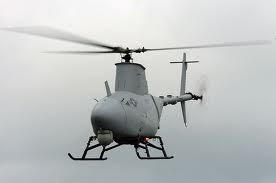
A Fire Scout Robotic Helicopter
During a routine test flight off the Pacific Coast of Latin America last April, a drone launched from a U.S. Navy frigate relayed back video of an open skiff speeding across the water. The U.S.S. McInerney had just come off duty chasing drug smugglers in the Caribbean, and the crew thought they knew what they were seeing. The speedboat was 20 miles ahead of the frigate and moving away as the sun went down. In the flight control room, operators instructed the drone to take up the chase.
Over the next three hours, the speedboat stopped twice and shut down its engine, a standard practice to listen for law enforcement aircraft. The drone, a 23-foot-long helicopter, trailed a mile or two behind, watching via night-vision camera. It was small and covert enough to evade detection. It also had the range to persist where a manned Seahawk helicopter, roughly twice its size, would have had to turn back and refuel. By the time the speedboat made its rendezvous with a fishing boat, under cover of darkness, the McInerney was on its tail. A flare went up as a Coast Guard boarding party moved in. The startled suspects immediately began dumping contraband, but 132 pounds of cocaine were recovered at the time of the arrest.
Until now, drones have been confined largely to war zones, where they have made a controversial reputation for killing both terrorists and civilians—so much so that the word "drone" itself causes some manufacturers to bristle. They say it ties them too narrowly to combat applications. Instead, they prefer acronyms like UAV or UAS (for unmanned aerial vehicle or system), or RPA (for remotely-piloted aircraft). But by whatever name (and "drones" seems to be sticking), unmanned aircraft will increasingly be overhead doing civilian work in this country. "It's not a matter of if, it's a matter of when," says Peter Singer, an analyst with the Brookings Institution—is it going to be 2012, 2014?—the point is, it's going to happen."
In fact, it is happening now. Unarmed versions of the military Predator already patrol thinly populated stretches of the nation's borders. They also fly into cities as hurricanes are passing through, sending down images to alert first responders to stranded survivors and downed utility lines. Backers and builders of drones say drones will soon also move into other jobs considered too "dull, dirty, or dangerous" for human pilots. To monitor marine mammal populations off Alaska, for instance, oil companies now rely on small manned aircraft flying at 300 feet, 200 miles offshore, in icy conditions. But a drone operated by the University of Alaska at Fairbanks recently did the job quietly enough not to scare off the animals—and at no risk to human life. Likewise, when smoke grounded conventional manned aircraft during a 2009 forest fire in Circle, Alaska, a drone provided infrared imagery that allowed officials to determine that no evacuation was necessary. And during the accident this spring at Japan's Fukushima Daiichi nuclear power plant, the world's largest drone analyzed the emergency from high altitude, while a backpack-size drone went inside to inspect the crippled reactors at close quarters.
Though plenty of people disagree, Mary "Missy" Cummings, director of MIT's Humans and Automation Lab, says drones will quickly lead to the demise not just of the "white scarf and leather jacket" pilot culture—but of human pilots period. She first saw the coming change in the early 1990s, she says, when she was a Navy fighter pilot landing a highly-automated F-18 on an aircraft carrier. "I saw how well it could fly on its own. On carrier landings, it always did better than humans." At some airports, Cummings notes, Boeing and Airbus jets can already take off and land without human hands on the controls. She predicts that within 10 years cargo flights will travel without human pilots, and commercial passenger traffic will ultimately follow.
And here's the bad news that could keep this from happening: A few months after that drug bust at sea, U.S. Navy operators in Maryland experienced a "lost link"—like losing your wireless connection– with the same model drone, a Northrop Grumman Fire Scout, as it was traveling at an altitude of 1700 feet and a speed of 70 miles an hour, straight toward Washington, DC. Military forces went on alert and contemplated the risks of shooting down a 3000-pound robotic helicopter in a heavily populated metropolitan region. The drone briefly entered restricted air space within 40 miles of the capital. Then, before the order for F-16 fighter jets to scramble, technicians on the ground finally regained control and turned the drone back to base. (Continued)
Ready to Take Off Part 2: The Gorge Does Drones
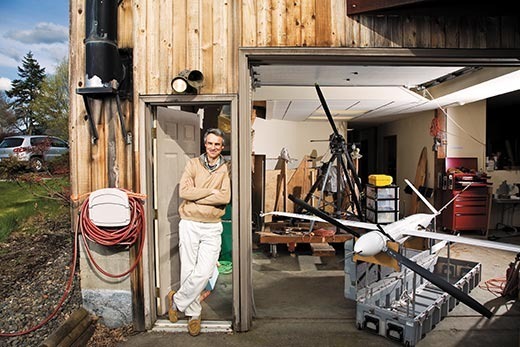
Tad McGeer at Aerovel's headquarters (photo by Robbie McClaran)
A good place to watch the developing drone revolution, with all its technological, commercial and ethical complications, is an hour east of Portland, Oregon, in the heart of the Columbia River Gorge, an area otherwise known for windsurfing, craft beer and political progressivism. Go almost anywhere on either side of the river—to an old school building in Bingen, Washington, say, or a former Chevy dealership in Hood River, Oregon—and you will find somebody working on drones.
The aeronautical engineer who got the industry started here is a boyish, reclusive character in his mid-50s with the perfect garage-inventor name, Tad McGeer. He runs the Aerovel Corporation, a start-up with nine employees, tucked behind a dense wall of pine trees in the rugged hills above Bingen. The entrance is a narrow gravel driveway with a broken-down gate. A wrecked Cessna sits in a derelict barn, and cars cluster around a big, blocky house at the end of a hayfield.
Inside, a staffer fabricates plane parts in what was once a child's bedroom, where the electronic controls for a coffin-like industrial oven now sit on a dresser decorated with beetles and snails. Aerovel's mechanical engineering laboratory occupies another bedroom, with horses and hearts painted on the walls. Test engines roar in the garages at either end of the house, and if it all looks a little makeshift, that suits McGeer just fine.
"Aren't we all amateurs?" he asks, his voice a low murmur that fades in and out like a distant radio station. "There are a lot of people doing what we do, tinkering in a garage."
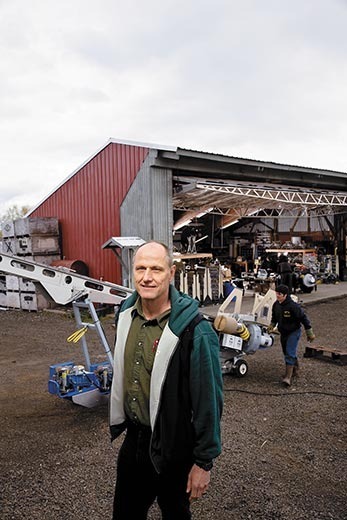
Andy von Flotow (photo by Robbie McClaran)
McGeer's longtime business partner, Andy von Flotow, operates in similar fashion on a farm on the Hood River side of the gorge. But where McGeer tends to be cautious and constrained, von Flotow is about moving obstacles aside and getting business done. He has a gleeful farm boy bearing, with sun-bleached blue eyes and weather-reddened skin. He also has a high regard for calculations scratched on the back of an envelope.
In a pear orchard nearby, von Flotow points out a trailer insulated with five tons of hay. It houses a fan capable of blowing air at 80 miles an hour through a 1,500-foot length of white silage tubing stretched out over a hill. In a meadow on the other side, a cradle built on an old orchard crate is designed to hold a drone running its engine at full speed in the silent wind.
"This is my Mil-14 meadow," von Flotow says, meaning that it meets military specifications for a sound-testing facility. (In addition to his partnership in Aerovel, von Flotow owns Hood Technology Corporation, which makes launchers, camera turrets and other military gear.) He uses the meadow in the dead of night to test different engine and muffler configurations. In springtime, the raucous calling of frogs in a nearby pond can pose a challenge. "So I phone the sheriff to tell them not to send the police and then I fire a shotgun twice." That buys him 30 seconds of silence.
McGeer and von Flotow, both Canadians who earned doctorates in aeronautical engineering from Stanford University, have spent much of their careers as seat-of-the-pants inventors, solving problems fast and cheap. Their idea of engineering is making something for a dime that any fool can make for a dollar, and having fun doing it.
McGeer got started in drones working on one of the first civilian models, the Perseus, which made its maiden flight over the Mojave Desert in November 1991. The hole in the ozone layer was a hot issue then, and the idea was that Perseus would take sophisticated measurements of atmospheric chemistry at high altitudes over Antarctica. But McGeer soon split off to develop the Aerosonde, a drone with a ten-foot wingspan that could take routine weather measurements by moving autonomously up and down through the atmosphere. He named the company Insitu, Latin for "in place." "It would not have been possible to conceive of the idea a few years earlier," says McGeer. But the U.S. government had recently opened the military Global Positioning System (GPS) to civilian use. Miniaturized computers, sensors and communications gear also made such a drone seem practical. (Continued)








Ready for Takeoff Part 3: Time for a Stunt
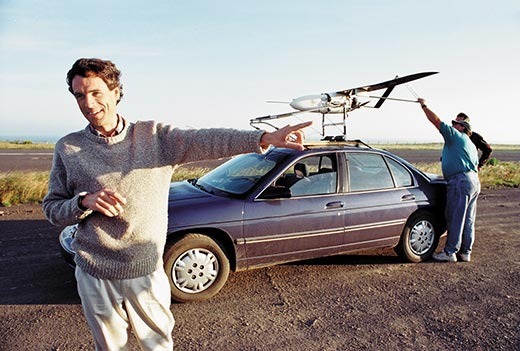
Preparing for the first Atlantic crossing
By 1998, McGeer was regularly flying Aerosondes, often operating out of an old school bus von Flotow owned. But atmospheric research was a niche market at best, with few customers in sight. "Maybe it's time for a stunt," von Flotow suggested. He had in mind the first Atlantic crossing by an unmanned aircraft. "I didn't want to do a stunt," says McGeer. "I wanted to fix our problems. We needed to test-test-test, break, fix, test-test, but we didn't have the money to do it."
He lost four aircraft in 200 hours of flight that spring—an average of 50 hours between failures. But even at $25,000 apiece, his cost at the time, drones are meant to be expendable. McGeer figured that an Atlantic crossing would take about 25 hours, "and I said, 'OK, so if we send four aircraft across the ocean, our chances that one will make it are better than 90 percent.' " A major defense contractor in San Diego was also planning the first Atlantic crossing, with a drone (and a budget) the size of a 737. The Los Angeles Times billed it as a David-and-Goliath contest.
That August, on Bell Island in Newfoundland, McGeer sent a rental car racing down the runway with an Aerosonde on top, the first of two launches that day. On South Uist Island in Scotland, a BBC crew set up movie cameras and waited. Back then, says McGeer, ground control could communicate with a drone for only about 50 miles at either end. The team programmed in GPS waypoints and prayed that the planes would find them on their own. The plan, developed with a meteorologist from the University of Washington, was to make the 2,000-mile crossing on 1.5 gallons of fuel. After both drones failed to arrive the next day, the BBC packed up and went home.
Three days later, McGeer launched two more drones. On South Uist the next day, a blip flashed on a laptop screen, then disappeared, leaving the landing crew tensely waiting. Soon after, a drone dropped down from the sky and landed softly in the grass. McGeer got the word by phone, in classic mission control monotone: "We have something you lost." When he returned his rental, McGeer was thinking, "'This is a historic car!' But we had scratched the roof a bit and decided not to mention it."
The achievement attracted potential customers in the tuna industry, which had suffered a series of deadly crashes of fish-spotting helicopters. The Pentagon also "began to make cooing noises," says McGeer; drones had been doing military work almost as long as there had been aircraft, with uneven results.
McGeer and von Flotow decided to focus on tuna. "Tad has a basic conflict with the Eisenhower military-industrial complex thing," says Juris Vagners, a colleague who teaches at the University of Washington. "He wants to do civilian stuff." For the tuna industry, McGeer and von Flotow developed the SeaScan, a drone with a camera turret. They also had to figure out how to make takeoff and landing user-friendly for fishermen working on the deck of a small ship. For the launch, they devised a catapult powered by a Sears, Roebuck air compressor, with a release mechanism triggered by a man yanking a rope. Recovery was more complicated.
McGeer eventually hit on the idea of flying one wing of the drone into a vertical rope, with the rope quickly slipping out along the leading edge of the wing to snag on a hook at the tip. Cutting the rope with the propeller wasn't an issue because the prop is mounted at the tail, safely out of the way. The problem was developing a hook that would cause the plane to hang in midair, rather than slide down the rope and smash into the ground.
They tested mechanisms on von Flotow's farm, using a plywood model of a SeaScan at the end of a five-foot rope. "I stood on a trailer and spun it around like a hammer thrower," recalls Cory Roeseler, who does what he calls "grunt engineering" for McGeer and von Flotow. But instead of releasing it like an Olympic athlete, he sidled the model over to a vertical line stretched down the corner of a barn. "When you hit the line, you can figure out which hooks snag and which hooks fail. You can do that in an afternoon. Good ideas rise to the top quickly if you have some plywood, a cordless drill and some good thinkers."
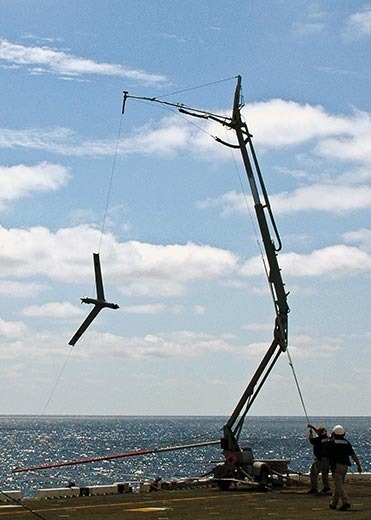
Skyhook
The "skyhook" technology they developed in this fashion now gets used a thousand times a month, on land and sea, almost always without incident. But it is still a spectacle. The drone circles for its approach, then comes whining in at about 50 miles an hour. GPS devices on the skyhook and the plane communicate, like air traffic control talking to a pilot, and the plane adjusts to an accuracy of a half-inch or less. Then it slams into the rope and snags 25 feet in the air, causing the skyhook to buck and sway as in an earthquake. "Holy Christ! That's violent," says a visitor seeing it for the first time. An engineer's view, says McGeer, with a proud, parental smile, is, "Just violent enough." (Continued)








Ready for Takeoff Part 4: The Military Connection
The changes McGeer came up with to attract the tuna industry also suited the military. Steve Sliwa, a college friend McGeer brought in to run Insitu's business side, was soon steering the company into a closer alliance with Boeing for defense work. McGeer's SeaScan became the ScanEagle, a 40-pound surveillance drone. During the Battle of Fallujah in 2004, the ScanEagle spotted would-be assailants and sent real-time video to troops on the ground. Military demand rose rapidly. There are now 18 ScanEagles aloft at any moment, according to Insitu, mostly in Iraq or Afghanistan, and the company is the largest employer in the Columbia River Gorge. The boast sometimes heard around town is that the rival Predator costs millions and works for generals, while a ScanEagle costs about $100,000 and works for gunnery sergeants.
The ScanEagle carries no weapons, but its camera helps target military strikes, and videos sent back to Insitu sometimes showed Iraqis being engulfed in flames. McGeer struggled with what he was seeing, and after losing a bitter boardroom confrontation, he quit the company in 2005. Three years later, Boeing purchased Insitu for about $400 million. According to von Flotow, he and McGeer split about 10 percent of the total. McGeer remains conflicted about it. "If you're a dead Iraqi," he says, "you might not think it worked out all that well."
It's a sentiment that echoes around the gorge, but quietly. Between them, Hood River and Bingen are home to fewer than 8,000 people, and neighbors inevitably run into one another at Brian's Pourhouse or the Wednesday night Secret Salsa dance club. Nobody wants to blame the conduct of war on neighbors who build the hardware. "It would be like blaming a bank teller for the financial crisis," says one local who works in the industry. Over a pint of a local brown ale, even a peace activist, retired attorney Susan Crowley, allows herself a sense of local pride in the idea of "boys having fun on the farm inventing things." But toward the bottom of the pint, she adds, "I think they would certainly like to do things other than killing people, or assisting in killing people." Von Flotow acknowledges that "nobody's happy about it." Then he adds: "Most engineering nerds are basically apolitical."
The question everyone asks is how quickly unmanned technology can make the leap into the civilian market. The potential seems limitless—handling routine monitoring of pipelines and power lines, for instance, or gathering geomagnetic data about natural resources (a job that entails flying hundreds of miles in a straight line, at low altitude, then moving 50 yards over and flying straight back). Drones could help farmers monitor crops in distant fields, allow developers to perform simple construction jobs in remote or difficult locations, or enable environmentalists to spot polluters.
But these applications face major regulatory issues.








Ready For Takeoff (If the FAA Let's 'Em) Part 5
Drone proponents complain bitterly that the FAA has limited the domestic market because of safety questions while at the same time the State Department has shut off the international market with strict limits on the export of defense technologies. New questions about privacy and civil liberties are also certain to arise. For instance, Aurora Flight Sciences, a Virginia firm, is testing a drone to conduct "wide area surveillance" over cities. Where a human observer might detect nothing, says Tom Clancy, the company's chief technology officer, computer algorithms can "extract behaviors or patterns of movement" suggesting ill intent—for instance, a car passing a bank four times before circling back and stopping. Would a court consider that probable cause for a police search?
The Brookings Institution's Singer believes that the adjustment to drones will be as challenging as the adjustment to horseless carriages at the start of the 20th century. Regulatory issues are the main reason the Teal Group, aerospace industry analysts, recently estimated that the nonmilitary portion of the drone market will grow only to $500 million a year by 2020, up from $300 million now. Meanwhile, the military market will double, from $5 billion worldwide today.
The problem, says John Allen, the FAA's director of flight standards, is that "there are too many lost [communications] links now. Some would say it's not that big a deal—'The aircraft continues to fly, it's not going to come plummeting to earth.' " Drones are typically programmed to go into a holding pattern—or return to base—when they lose contact with ground control. "Well, that might be fine in a combat environment," Allen says, "but in a civil environment, with a very congested national airspace, that creates a problem."
Under current FAA rules, operators of unmanned aircraft must have a certificate of authorization; only 264 such certificates are active, most for research and development in remote areas. "What they would like," says Allen, "is to not have to go for that permission every time," and simply file a flight plan and take off, like manned aircraft. But human pilots can see and avoid small planes flying by visual flight rules. Many drones, he says, lack the technology to "sense and avoid."
The FAA is considering rules that would continue to separate unmanned aircraft from conventional air traffic but relax restrictions on drones weighing less than 50 pounds and flying below 400 feet. Allen predicts the change, likely to take effect late next year, will spur entrepreneurs and government agencies to launch thousands of new drone applications. But opening the national airspace to larger drones—some with the wingspan of a passenger jet—will be more complicated, he says, requiring "a lot of cultural change" and more reliable technology.
One watchdog database lists more than 50 accidents involving large military drones since 2007. Most took place in Afghanistan or Iraq, where combat sometimes requires pushing a drone to unsafe extremes. But a Predator providing surveillance along the Mexican border crashed in this country, when an operator accidentally shut off its engine. Officials at U.S. Customs and Border Protection and the FAA disagree about whether the Predator's domestic record adds up to a few minor mistakes over four years of safe civilian operations—or 350 times the accident rate for commercial aviation.
The concern expressed even by some in the drone community is that a careless accident early on could be a disaster for the entire industry. The first fatality involving a civilian drone has already occurred. In August 2009, a Yamaha RMAX helicopter, a commercial drone about the size of a motorcycle, crashed while crop-dusting a field in South Korea. Part of the rotor sheared off and penetrated the abdomen of a bystander, who bled to death. Yamaha has since halted RMAX production.
"We have accidents more often because we're not carrying people," says Sliwa. "The safety systems on manned aircraft are designed for a ten-to-the-minus-six probability of an accident." That's one in a million. For unmanned aircraft, he said, it's more like a ten-to-the-minus-four thing. That's one in 10,000. "But we'll get there. Back when our parents were growing up, there was a form of transport you would not get into without a human operator, and that was an elevator. Now we step in and push a button."
But the real obstacle, McGeer argues, isn't regulation—it's cost. There are a lot of human pilots out there, and they love what they do. So their services come cheap. You can rent a piloted Cessna for as little as $100 an hour, he says.
Unmanned aircraft typically require at least two people, and sometimes many more, doing ground control. The work involves sitting in front of a computer for hours at a time, so no one does it for fun. Drones also represent a relatively new technology, with high research and other start-up costs for a product that's still manufactured in relatively small numbers.
Costs will almost inevitably come down. For instance, it may be possible to develop systems that enable one ground controller to handle four or five drones at a time. To alleviate FAA concerns about that approach, Insitu executive Paul McDuffee suggests, a UPS or FedEx plane might have one human pilot to communicate with air traffic control—and three unmanned planes flying in formation behind. It is, he acknowledges, "a Buck Rogers theoretical concept." McGeer is skeptical. Congressional earmarks may support a few civilian uses, but earmarks are drying up. For now, he believes the military is likely to remain the primary buyer of unmanned aircraft.
###








Ready for Takeoff Part 6: Back at the Farm
In an alley between two vineyards on his farm, von Flotow watches staffers use a catapult launcher to fire a 150-pound hunk of rusting steel up a zip line. They're testing brake systems to stop the hunk of steel before it comes slamming back down. They need to get the braking right because this is how they will soon test a new multimillion-dollar military drone packed with pricey electronics.
To a casual observer, it looks like boys on the farm having fun. But they're working on a joint Navy and Marine contract recently won by Insitu, and, von Flotow says, it is complicating their lives. Instead of getting an idea and trying it out the same afternoon with a cordless drill and some plywood, "we have to wait for hundreds of guys in Maryland to tell us what to do," he says. And instead of working for the fun of it, they must now account for their time in ten-minute increments. It's the nature of military contracting: What they used to do for a dime can end up costing a dollar.
Over at Aerovel, meanwhile, McGeer is back where he started 20 years ago, thinking about the weather. What he has in mind is a drone that could take off from the West Coast, land itself on a ship in Hawaii to refuel without human assistance, then take off and fly home again, over and over, continuously sending back low-altitude weather data. It is a typically quixotic project. The lack of good storm-intensity forecasts has huge economic costs, but filling that need won't automatically generate big profits because the economic benefits are too widely diffused.
McGeer wants to accomplish the new mission with a drone that can take off and land vertically, eliminating launchers and skyhooks. Efficient vertical takeoff and landing, or VTOL, is "historical snake oil in the aeronautical industry," he admits. For decades, science magazines have conjured up futuristic visions of such vehicles taking off from people's driveways, but the trade-offs required to get both the hovering ability of a helicopter and the forward speed of a fixed-wing aircraft have grounded most such aspirations. McGeer thinks he has a better idea, and new technology to make it happen.
The test drone stands on the driveway outside his garage, its engine roaring. It's just a stripped-down tube, capable for now only of takeoffs and landings, not horizontal flight. In place of wings, there's just a stick, like a scarecrow's arms. Lately, the engine has been dying mysteriously after two or three hours. A staffer has put in an order for a carburetor rebuild kit, but it will take a day or two to arrive. "Isn't it just a chain saw carburetor?" McGeer asks. It starts to rain, which is a problem because they haven't sealed up the avionics yet. McGeer is undaunted. The "test-test-test, break, fix, test-test" mantra is his life.
Better to come back another day, he suggests. He isn't making any promises. But it might just fly.








May 12, 2011
In Namibia: Letting People Own the Wildlife

Springbok at Kulala Desert Camp (Mike Myers/Wilderness Safaris)
One of the most impressive transformations I noticed on my recent visit to Namibia is how local communities are taking over the job of wildlife conservation. Here's an account I wrote for Yale Environment 360.
The first time Arno Grobler visited the office of the ≠Khoadi-//Hôas Conservancy in northwestern Namibia, he was, he admits, "flabbergasted." The Conservancy has the job of managing wildlife, and drawing income from it, on a 1400-square mile patch of desert. It is starkly beautiful red rock country, inhabited by rhinos, elephants, lions, leopards, cheetahs, and other wildlife.

Hot times in ≠Khoadi-//Hôas
But conservancies in Namibia are run by local community groups, often livestock farmers with little education, limited experience in double-entry accounting, and no love for predators. About 4000 people live in the ≠Khoadi-//Hôas area (those punctuation marks represent clicks and pops in the local Nàmá language), and cattle frequently camp out on the only intersection for miles. So what startled Grobler, who had just become manager of a tourist lodge there, was how "clued up" the Conservancy seemed to be: Slick full-color posters on the walls listed rare and endemic species. Three-ringed binders on the shelves recorded cases of human-wildlife conflict. And the business manager used an Excel database on her laptop computer to track the conservancy's annual budget. Turning to his partner, Grobler whispered, "I think we're in for something completely different."
It's a thought that's liable to occur to any visitor checking out Namibia's system of conservancies, if only because the idea of having communities manage their own wildlife, though much talked about elsewhere, actually seems to be working there. Starting from nothing in 1998, Namibia now has 64 community conservancies, covering about 17 percent of the national land area, slightly more land than is in national parks or other forms of state protection.
The conservancies aren't parks; most residents continue to work herding livestock. But they set aside a portion of their common land—30 percent in the case of ≠Khoadi-//Hôas—exclusively for wildlife. The vision, as a farmer and field officer at another conservancy put it, is to "give benefits and create jobs through consumptive and nonconsumptive uses of wildlife"—that is, hunting and tourism. It has worked so well that the Ministry of Environment and Tourism now often translocates animals—including critically endangered black rhinos–out of overcrowded national parks onto unfenced conservancy land, where they have room to recover to their former numbers. The community's material interest in the wildlife also means there are enough watchful eyes to limit poaching. The result is that, where Kenya and many other African nations are rapidly losing their wildlife, Namibia has registered a sharp increase.
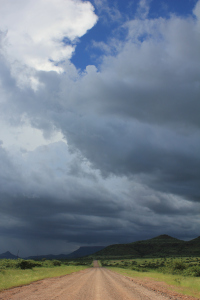
On the road in Namibia (James Conniff)
The community conservancy idea works in Namibia for one obvious reason: Just 2.1 million people live in this arid country on the southwest coast of Africa, and six people per square mile make for a better mix with wildlife than the 158 in Kenya, or the 94 in neighboring South Africa. Namibia has also enjoyed a run of favorable rains since the mid-1990s, helping prey species like springbok and gemsbok, and thus lions and other predators, too.
But one almost unimaginable change in the mid-1990s gave the conservancy concept special credibility in Namibia: The national government turned ownership of the wildlife back to the people. If that does not seem like a bold idea, think of it as if the U.S. Fish and Wildlife Service handed gray wolf recovery over to cattle ranchers in Wyoming (which, incidentally, has a comparable population density of just 5.1 people per square mile).
Liberation politics played a key part in this innovation. Until 1990, Namibia was administered by South Africa's Apartheid government. Private landowners, mostly white, had enjoyed the right to exploit the wildlife on their properties since the 1970s. But the government then regarded the idea of "giving ownership to the subversive black community" as lunacy, says environmentalist Margaret Jacobsohn. After independence, though, community ownership "fit with the rhetoric of SWAPO," the former liberation movement that is now Namibia's dominant political party, adds Garth Owen-Smith, the grand old man of the Namibian environmental movement. "It appealed to the more idealistic elements of our government," as well as to those who "wanted to lash out at all the South African laws. It almost slipped in before people realized it."
The CAMPFIRE program in Zimbabwe served as a model for the idea of community-based wildlife management. But a home-grown precedent also made this approach seem practical: In the 1980s, Owen-Smith had successfully fought poaching in northwestern Namibia by hiring community game guards and having them report not to him, but to their traditional leaders. "That gave them ownership," at least symbolically he says.
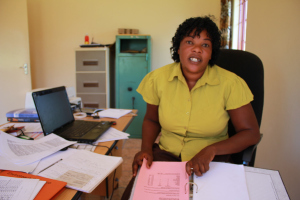
Hilga Howoses is now the ≠Khoadi-//Hôas Conservancy's business manager
Literal ownership wasn't something communities in Namibia were sure they wanted, in the beginning. "First we had to mobilize the people," says Hilga Howoses, who helped organize ≠Khoadi-//Hôas in 1998 as one of the first registered conservancies. "They didn't want to live with predators and the elephants, but we mobilized them. The Ministry of Tourism and the Environment gave us the awareness that benefits will come in the future." Actually getting to those benefits was –she sighs–"quite difficult. If you start something from scratch you don't have any idea how to begin, how to organize." But the ≠Khoadi-//Hôas Conservancy now earns about $172,000 a year—big money in a rural culture where people live on a dollar a day–and has created jobs for more than 30 area residents. Overall, conservancies earned about $5.3 million in direct income and generated about $40 million for the Namibian economy in 2009.
The money comes from a mix of uses. Trophy hunting is typically the first source of revenue. "If you have a vehicle and a canvas tent, then almost overnight a conservancy can be covering its costs," says Greg Stuart-Hill of the World Wildlife Fund in Namibia. "If people have to wait 10 years for benefits, they might just walk away and go back to livestock." The government still sets limits based on sustainability, but trophy fees range from $1000 for a kudu up to $25,000 for an elephant, so "people see that the wildlife does have value," says Chris Weaver, WWF's managing director, "and poaching stops almost overnight, because you're no longer stealing from the government, you're stealing from your neighbors. It becomes socially unacceptable."
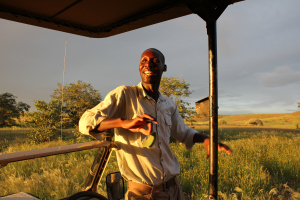
Desert Rhino Camp guide Makumbi Swenyeho
Though they are harder to get established, safari lodges for camera tourists are a larger source of both income and employment. They are typically built and run by outside companies in partnership with the conservancies, and Namibia now has 44 such joint ventures, providing 800 full-time jobs. "Responsible tourism is the way to do it," says a member of the staff at one such safari lodge, Desert Rhino Camp. "People see the benefits. They see the opportunities for their children. All the guys who work here grew up as herd boys. Now they are trackers, guides, head waiters, some of them are even managers."
The social psychology can prove more challenging than the double-entry accounting. For instance, hunters and tourists need to be zoned in separate areas, or separate seasons, because neither wants to know that the other exists. "You don't want hunters sitting in the same bars and restaurants talking about their hunt that day with people who are talking about the beautiful baby animals they've just seen," says Weaver. More seriously, ancient hostilities familiar to all livestock farmers still inevitably surface, especially as new management practices increase the number of predators. At ≠Khoadi-//Hôas, problem animal incidents ("baboon killed two goats," "jackal killed one goat," "leopard killed one donkey") have risen from just 35 in 2001 to almost 300 last year. A few miles from the conservancy office, for instance, John Tijpute, 41, says he recently lost six sheep when a leopard came into his corral one night. He has only two sheep remaining for his family of eight, and like livestock farmers everywhere, he wants to be compensated for the loss. But then he also adds: "The conservancy is protecting our animals, which the tourists are coming in to see. The economy of the country is going up because of these animals."
That phrase, "our animals," and the subtle change in attitude it implies, has delegations visiting from around the world to see if they can replicate the Namibian experience. Nepal wants to try it to protect its tigers and rhinos, says Owen-Smith, and Mongolia is interested in finding a better way to manage its argali sheep. He urges them not to omit the one essential change they may find hardest to stomach in the way they manage wildlife: "Do it according to your own laws and bureaucracy, but give the ownership back."
On private land, meanwhile, the Namibian model is already taking hold in the Sandhills of Nebraska, where the traditional cattle ranching culture can provide a meager living at best. The Grassland Foundation there now regularly sends scholars and interns to community conservancies in Namibia. The idea, says Grassland's president Tyler Sutton, is to find ways to do better by wildlife and earn better returns for ranchers in the Northern Great Plains. As a result, three privately-owned ranches have already begun collaborative planning on how to benefit from their resources, moving beyond cattle into bird-watching, hunting, horseback riding, and river trips.
And, if it works, who knows? From the Sandhills of Nebraska, the cattle ranchers of Wyoming are practically next door.

Giraffes at Palmwag Lodge (Dana Allen/Wilderness Safaris)
May 11, 2011
New Edition of The Species Seekers
Adding to my collection of books I have apparently written, but cannot read, the new Polish edition of The Species Seekers (or rather Poszukiwacze Gatunków) is now out from Prószyński i S-ka. Nice cover, anyway:








May 8, 2011
Slave to Conventional Prejudice

Hume had a limited idea of civilization
In a rhapsodic New York Times op-ed about David Hume's love life, Robert Zaretsky manages to use the word "slave" three times ("reason is indeed passion's slave") and also quotes the advice from a friend that Hume should use his mind only in "the service of that portion of mankind we call our country."
But maybe we should also remember that Hume was concerned only with a narrow segment of humanity. He once wrote, "There never was a civilized nation of any other complexion than white."
In that spirit, he also belittled, sight unseen, a schoolmaster named Francis Williams: "In JAMAICA indeed they talk of one negroe as a man of parts and learning; but 'tis likely he is admired for very slender accomplishments, like a parrot, who speaks a few words plainly."
These thoughts parroted conventional thinking of the day, which was obsessed with whether other races were even members of the human species (as I recount in The Species Seekers).
But they also make it clear that the eminent philosopher was right to be skeptical about the powers of reason.








May 3, 2011
Sliming Osama

Under the sea: Osama makes new friends
This morning, I received a kind note from a reader, who found herself thinking oddly about Osama bin Laden after reading my book Spineless Wonders: Strange Tales from the Invertebrate World:
I just read Spineless Wonders in December, and enjoyed it very much. Some of the creatures described were new to me, and I was amazed to find myself feeling sympathetic for the tarantulas. However, the book led to a most unpleasant flashback when I awoke this morning, to the radio news announcing that the body of Osama bin Laden had been "buried at sea".
My first coherent thought was not about peace or justice or the war on terrorism. It was, "Hagfish!!!"
I'm afraid that in this case, I wish the hagfish well, and hope they will get some protein and profit from the deceased.
Thank you very much for your outstanding writing; I am looking forward to reading your other titles.
Hagfish, for those of you who have never had the strange pleasure of making their acquaintance, are scavengers on the ocean bottom. Sometimes, fishermen encounter them in their catch, and here's what I wrote in Spineless Wonders:
It is a disheartening sight for fishermen, touching some source of horror beyond mere economic loss. One fisheries expert has attributed this horror to the slime itself: "Being worthless … the hag is an unmitigated nuisance, and a particularly loathesome one owing to its habit of pouring out slime from its mucous sacs in quantity out of all proportion to its small size. One hag, it is said, can easily fill a 2-gallon bucket, nor do we think this any exaggeration."
But a far graver problem with slime eels, it seems to me, is that they make the idea of burial at sea so much less appealing. Once having seen them, seafarers must suffer forever from foreboding that if they go down with the ship (or without it), slime eels will be waiting for them at the bottom. Martin Cruz Smith employed this idea to fine effect in his novel, Polar Star, in which a Soviet murder victim returns from the bottom in a trawler net. As investigators examine a knife wound in the victim's gut, they notice a protruding "length of intestine, purplish-gray and slick …" which gradually becomes recognizable as a slime eel: "The eel's head, an eyeless stump with fleshy horns and a puckered mouth, whipped from side to side against Zina Patiashvili's stomach; then the entire eel, as long as an arm, slid seemingly forever out of her, twisted in mid air …" and landed at the examining physician's feet.
This scene is a figment of Smith's imagination. No one has ever found a human corpse being scavenged from within by slime eels. In truth, most researchers believe that even fish corpses are a relative rarity in the diet of slime eels, which are more likely to subsist on worms, shrimp, and other small sea-bottom creatures. But it is at least conceivable that hollowed-out shipwreck victims have at times drifted across the bottom like Michelangelo's self-portrait as a sack of skin on the ceiling of the Sistine Chapel …
And now we can hope that Osama bin Laden is meeting this fate, in his element among the slime eels.





























